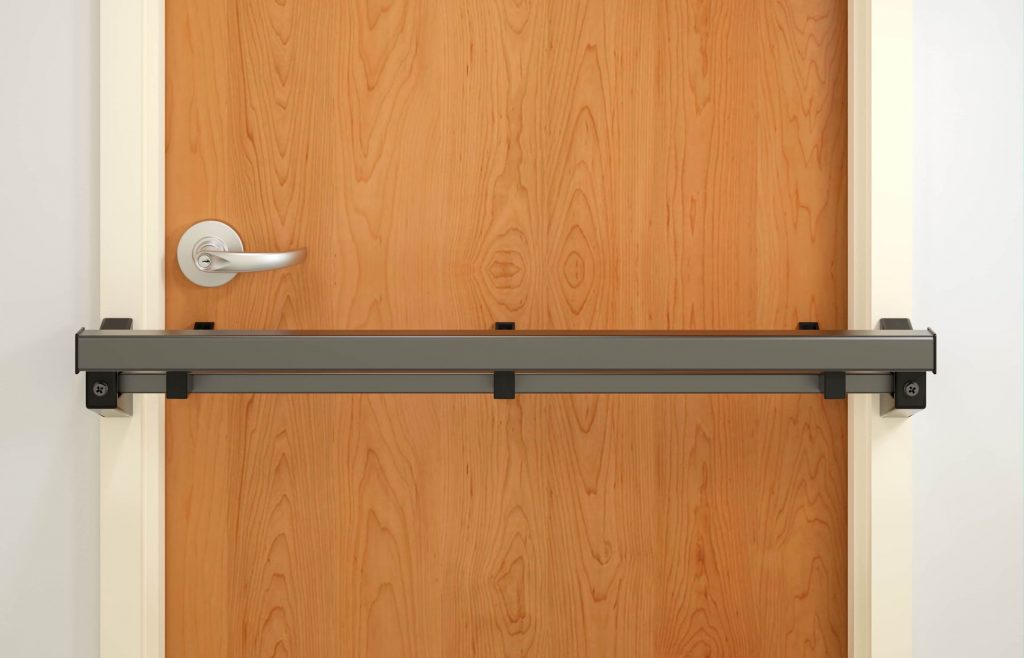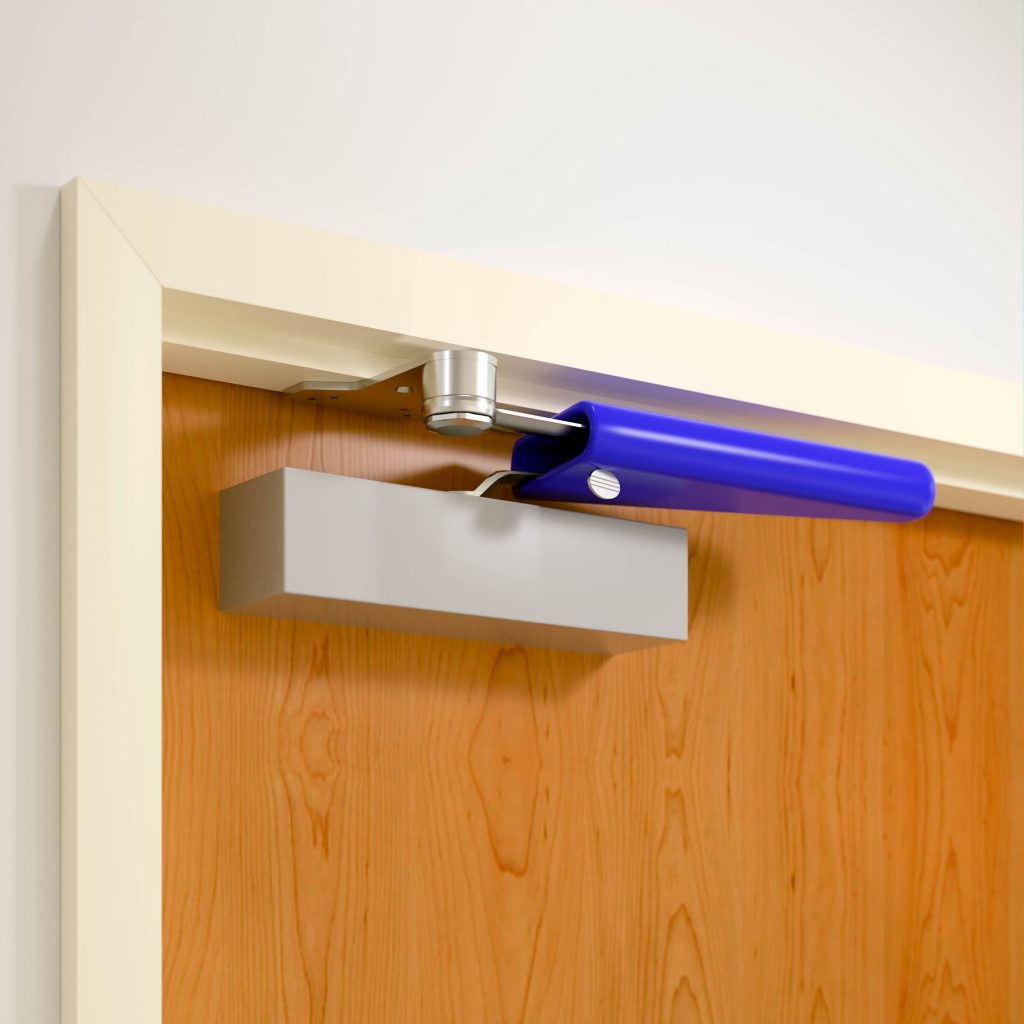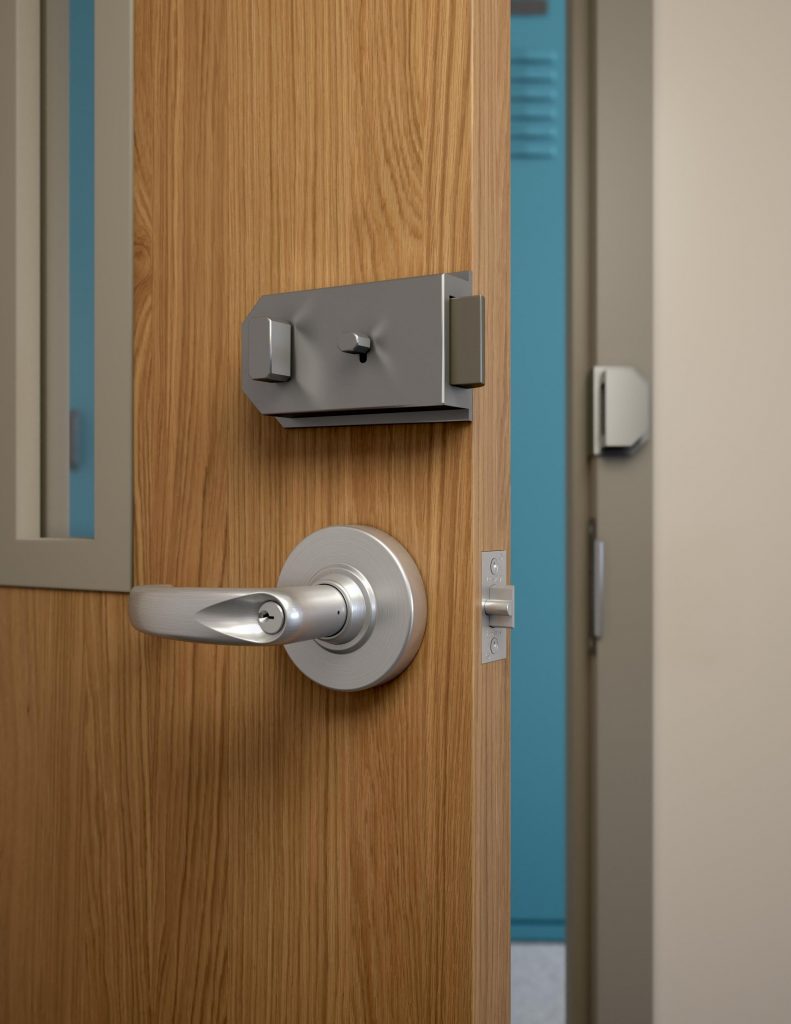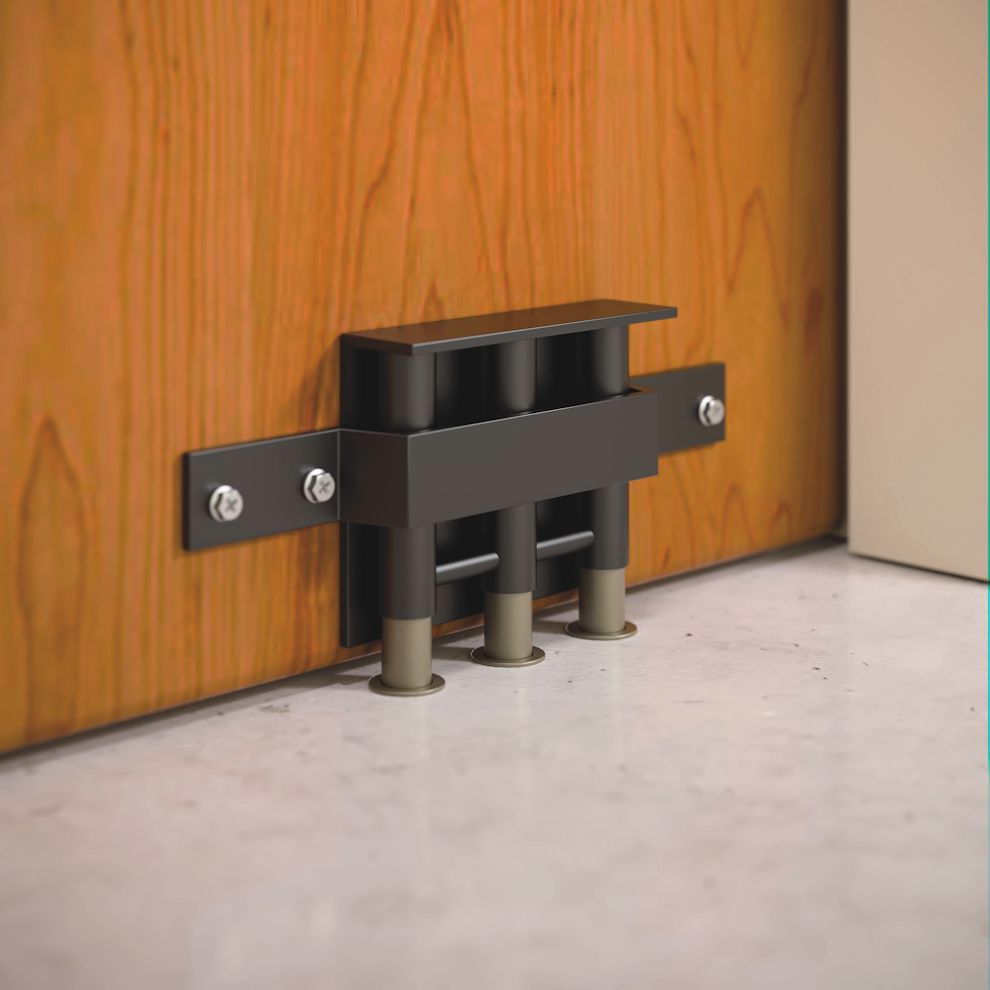Now that the NFPA 101 vote has passed, the 2018 model codes will be pretty consistent with regard to classroom security. I pulled together information from the IBC, IFC, and NFPA 101 for the article below, and I will create a PDF that can be used for educational purposes. I’m also working on some Powerpoint slides and a short video to help inform school districts, code officials, and others. Let me know if there’s something specific you would like to see included.
UPDATE: Two appeals to the 1-operation language in NFPA 101 have been filed. I have revised the article below to reflect the appeals. I will share more specifics as soon as the documentation is made available to the public.

Some school districts may consider classroom barricade devices because they are less expensive and easier to procure than traditional locksets, but most retrofit security products do not meet the requirements of the model codes and standards—particularly when installed along with existing hardware.
For several years, as school districts attempted to address security concerns within budgetary limitations, some districts have looked beyond traditional locking hardware for options that are easier and less expensive to procure and install. Although current (and past) model codes include prescriptive requirements to ensure free egress, fire protection, and accessibility, these have sometimes been overlooked in the rush to secure classroom doors. Classroom barricade devices were developed to address these security needs, without test standards or certifications to ensure that safety was also considered.
Some proponents of classroom barricade devices have attempted to cast doubt on the need for classroom doors to comply with stringent code requirements during an active assailant situation, stating that there is a low risk of fire and therefore the codes that mandate free egress and fire protection are not binding; in reality, fires and other types of incidents are much more common than school shootings. The accessibility requirements have largely been ignored with regard to these products, as security became the primary goal.
Model Code Changes
During the current model code cycle, the requirements for classroom security were widely examined, discussed, and debated, to determine whether the code requirements that have been in place for decades should be relaxed. Looking at school security and safety from an all-hazards perspective, the decision was made to maintain existing requirements and add an additional mandate to strengthen the current codes for classroom security. Code change proposals have now been approved for the 2018 editions of the International Building Code (IBC) and the International Fire Code (IFC). Proposals for NFPA 101 – The Life Safety Code are currently under appeal.
The IBC applies to new buildings and alterations in most jurisdictions across the US, and this was the first of the 2018 proposals to be approved:
1010.1.4.4 Locking arrangements in educational occupancies. In Group E and Group B educational occupancies, egress doors from classrooms, offices and other occupied rooms shall be permitted to be provided with locking arrangements designed to keep intruders from entering the room where all of the following conditions are met:
1. The door shall be capable of being unlocked from outside the room with a key or other approved means.
2. The door shall be openable from within the room in accordance with Section 1010.1.9.
3. Modifications shall not be made to listed panic hardware, fire door hardware or door closers.
1010.1.4.4.1 Remote operation of locks. Remote operation of locks complying with Section 1010.1.4.4 shall be permitted.

Panic hardware, fire door hardware, and door closers must not be modified in order to install retrofit security devices.
The key points in this approved change are:
- This code language applies to K-12 schools and also colleges and universities.
- The locking requirements apply to classrooms as well as offices and other occupied rooms.
- If the rooms are lockable, they must be able to be unlocked from the outside using a key or other approved means (this is new).
- Locks are not required, but if locks are used, the doors have to meet the requirements for egress – one operation to unlatch, no key/tool/special knowledge/effort, no tight grasping/pinching/twisting, etc.
- Listed panic hardware, fire door hardware, and door closers must not be modified to accommodate retrofit security devices.
- Remote operation is acceptable if the locks meet the other requirements of this section.
Similar language was approved for the IFC, which is enforced throughout the life of the building when the IFC has been adopted as the fire code for a facility’s jurisdiction. The IFC language was expanded slightly to include Group I-4 child day care occupancies, and to state that modifications made to fire door assemblies must be in accordance with NFPA 80 – Standard for Fire Doors and Other Opening Protectives. Compliance with this standard is already required by all of the model codes for doors that are fire rated, but it is reiterated in the IFC’s classroom security section to reinforce that any modifications and/or products used for classroom security on fire doors must meet the NFPA 80 requirements, including testing and listing the locking devices to UL 10C – Standard for Positive Pressure Fire Tests of Door Assemblies.

The NFPA 101 proposal to allow two releasing operations on existing classroom doors was rejected by NFPA voters and almost unanimously opposed by the Technical Committee on Means of Egress, but the language requiring one operation is under appeal.
In the code change proposals for NFPA 101, the language is again similar to the other model codes, but originally the proposed language allowed two releasing operations for hardware on existing classroom doors instead of the one-operation requirement that had been included in the Life Safety Code since the 1988 edition. Members of the NFPA Technical Committee on Means of Egress were almost unanimously opposed to the two-operation language, and several organizations and individuals spoke against this portion of the proposal at NFPA’s technical meeting. The members voted to reject the two-operation proposal and keep the long-standing requirement for one releasing operation to unlatch egress doors, however, this language is currently under appeal.
Accessibility
Doors on an accessible route are required to meet the accessibility standards to provide access and egress for all. The 2010 ADA Standards for Accessible Design, and ICC A117.1 – Accessible and Usable Buildings and Facilities are the standards that apply to most new and existing buildings in the US. Both of these publications require hardware to be operable with no tight grasping, pinching, or twisting of the wrist. In addition, the releasing hardware must be mounted between 34 inches and 48 inches above the floor or ground to ensure that it’s within the accessible reach range.
ADA Advisory 404.2.7 states that the greatest range of users are accommodated by door hardware that is operable with a closed fist or a loose grip, without simultaneous hand and finger movements which require greater coordination and dexterity. Lever-handle locksets and panic hardware are designed to meet the accessibility standards and are operable within the parameters of the ADA and A117.1. Many retrofit security devices are either mounted above or below the required height range for releasing hardware, and/or require tight grasping, pinching, or twisting of the wrist to operate.
State Code Modifications
States and local jurisdictions may modify the model codes rather than adopting the codes exactly as written. In order to allow the use of security devices that do not meet the model codes or standards, states must modify their codes, or the Authority Having Jurisdiction must approve the use of the products. A few state fire marshals have released bulletins stating that classroom barricade devices may be used during an active assailant incident, although this is inconsistent with guidelines for classroom security from the National Association of State Fire Marshals (NASFM). In Ohio and Arkansas, the state legislatures passed laws which allow classroom barricade devices; in both states this was done despite the objections of the state code officials.

This type of security device which engages into a floor strike is not mounted within the allowable range of 34 inches to 48 inches above the floor or ground, and may be difficult for some users to operate. When mounted on the push side of the door, this type also conflicts with the accessibility requirement for a flush, smooth surface on the face of the door within 10 inches above the floor.
Neither of these state laws require the locking devices to be operable without tight grasping, pinching, or twisting of the wrist, or to be mounted within the accessible range. Arkansas Senate Bill 796 (2015) does not impose any limitations on the use of barricade devices, as the entire text of the law is: “A person may install and use a temporary door barricade device or security lockdown device for security purposes to protect individuals during active shooter events or other similar situations.” The Ohio code change references the ADA but does not specifically require compliance, stating, “Provisions of the ‘Americans with Disabilities Act of 1990,’ 104 Stat. 327, 42 U.S.C.A. 12101, as amended, may apply to the use of the temporary door locking device but are outside the scope of this code.”
While states allowing barricade devices may have failed to consider the accessibility standards, the Guide for Developing High Quality School Emergency Operations Plans states that plans must comply with the Americans With Disabilities Act (ADA), along with other prohibitions on disability discrimination. This guide is a joint publication of the US Department of Education, the US Department of Health and Human Services, the US Department of Homeland Security, the US Department of Justice, the Federal Bureau of Investigation, and the Federal Emergency Management Agency.
Conclusion
Based on the model code changes, it’s clear that the intent is for classroom doors to provide free egress, fire protection, and accessibility. School districts should also consider the potential liability associated with the use of devices that may be installed by an unauthorized person to secure a classroom and commit a crime. If someone is injured in a barricaded classroom, the school may be held liable for failing to meet their duties of care. Many listed products exist which provide the necessary level of security while also meeting the model codes and standards. As noted in the final report of the Sandy Hook Advisory Commission, “The testimony and other evidence presented to the commission reveals that there has never been an event in which an active shooter breached a locked classroom door.”
You need to login or register to bookmark/favorite this content.






Thank God that common sense prevailed!
Good summary – do you have those PPT slides you could share?